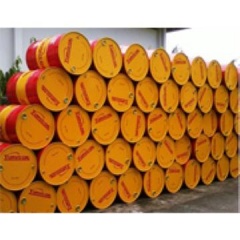Lubricating Oils
| Infobox on Lubricating Oils | |
|---|---|
| Example of Lubricating Oils |  |
| Facts | |
| Origin | - |
| Stowage factor (in m3/t) | 1,47 m/t (drums) |
| Humidity / moisture | See text |
| Ventilation | - |
| Risk factors | See text |
Lubricating Oils
Contents
Description
Motor oil or engine oil is an oil used for lubrication of various internal combustion engines. The main function is to lubricate moving parts; it also cleans, inhibits corrosion, improves sealing, and cools the engine by carrying heat away from moving parts.
Motor oils are derived from petroleum-based and non-petroleum-synthesized chemical compounds. Motor oils today are mainly blended by using base oils composed of hydrocarbons, polyalphaolefins (PAO), and polyinternal olefins (PIO), thus organic compounds consisting entirely of carbon and hydrogen. The base oils of some high-performance motor oils however contain up to 20% by weight of esters.
Most motor oils are made from a heavier, thicker petroleum hydrocarbon base stock derived from crude oil, with additives to improve certain properties. The bulk of a typical motor oil consists of hydrocarbons with between 18 and 34 carbon atoms per molecule. One of the most important properties of motor oil in maintaining a lubricating film between moving parts is its viscosity. The viscosity of a liquid can be thought of as its "thickness" or a measure of its resistance to flow. The viscosity must be high enough to maintain a lubricating film, but low enough that the oil can flow around the engine parts under all conditions. The viscosity index is a measure of how much the oil's viscosity changes as temperature changes. A higher viscosity index indicates the viscosity changes less with temperature than a lower viscosity index.
Motor oil must be able to flow adequately at the lowest temperature it is expected to experience in order to minimize metal to metal contact between moving parts upon starting up the engine. The pour point defined first this property of motor oil, as defined by ASTM D97 as "... an index of the lowest temperature of its utility ..." for a given application, but the "cold cranking simulator" (CCS, see ASTM D5293-08) and "Mini-Rotary Viscometer" (MRV, see ASTM D3829-02(2007), ASTM D4684-08) are today the properties required in motor oil specs and define the SAE classifications.
Oil is largely composed of hydrocarbons which can burn if ignited. Still another important property of motor oil is its flash point, the lowest temperature at which the oil gives off vapours which can ignite. It is dangerous for the oil in a motor to ignite and burn, so a high flash point is desirable. At a petroleum refinery, fractional distillation separates a motor oil fraction from other crude oil fractions, removing the more volatile components, and therefore increasing the oil's flash point (reducing its tendency to burn).
Another manipulated property of motor oil is its Total Base Number (TBN), which is a measurement of the reserve alkalinity of an oil, meaning its ability to neutralize acids. The resulting quantity is determined as mg KOH/ (gram of lubricant). Analogously, Total Acid Number (TAN) is the measure of a lubricant's acidity. Other tests include zinc, phosphorus, or sulfur content, and testing for excessive foaming.
The NOACK volatility (ASTM D-5800) Test determines the physical evaporation loss of lubricants in high temperature service. A maximum of 15% evaporation loss is allowable to meet API SL and ILSAC GF-3 specifications. Some automotive OEM oil specifications require lower than 10%.
See also Bulk Oils and Fats











